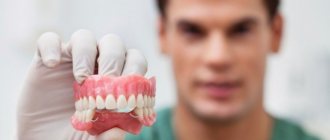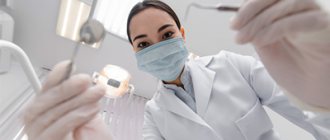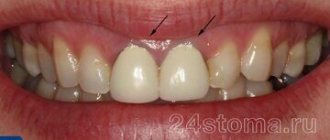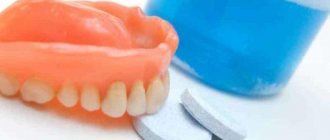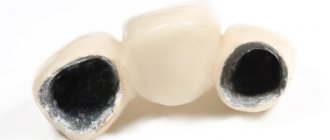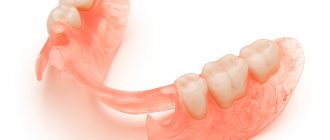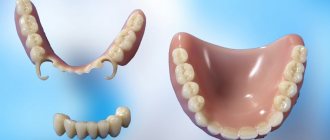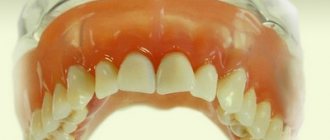Fixed dentures - features and advantages
Fixed dentures are considered the most effective and inexpensive solution to restore dentition.
The most common causes of tooth decay and subsequent loss are:
- abundant carious lesions;
- pulpitis;
- periodontitis;
- dental cysts, etc.
As a result of these dental diseases, tooth crowns and roots are destroyed, teeth fall out on their own, or surgical intervention is required to remove dead hard tissues and roots. For restoration, the dentist recommends permanent dental prosthetics, the basis of which is a bridge and ceramic crowns of the latest generation.
Advantages of fixed dentures:
- Aesthetics. Fixed dentures are difficult to distinguish from your teeth. With proper selection and proper installation, the design looks harmonious in the oral cavity, and the person smiles boldly.
- Comfort. A person quickly gets used to a fixed denture and does not feel discomfort afterwards.
- There is no need to build up bone for high-quality implementation of a fixed denture. When using modern artificial roots, there is often no need to build up bone tissue. This simplifies the entire dental procedure and makes it much more affordable.
- Fast payback. The investment in fixed dentures always pays off in dental health, attractive visual effect and durability.
Removable dentures. What to prefer?
If all or a significant part of the teeth are lost, the patient will be offered the installation of a removable denture. The removable design is a plastic plate that fits tightly to the mucous membrane and follows its shape. This ensures its strong attachment in the oral cavity. Artificial teeth are attached to the plate, imitating the patient’s own lost dental units. There are two types of removable structures: partially removable and completely removable.
The best partially removable designs
Partially removable dentures are used for partial restoration of the dentition. This type of denture is indicated if only part of the teeth are missing. Plastic and nylon are used for manufacturing. Special hooks or special clasps are used as fastening means. The fasteners are quite strong and provide reliable fixation of the dentition.
Main advantages and disadvantages
Partially removable structures are universal and have many advantages:
- The chewing load is evenly distributed, which ensures the safety of the dentition.
- The oral care procedure is simple and easy.
- Durable clasps provide reliable fixation in the oral cavity.
- The prosthesis ensures complete restoration of chewing function.
- Due to the uniform load, deformation of some dental units is excluded.
Among the disadvantages are the following:
- Dentures are quite expensive.
- Not all designs are sufficiently aesthetic, so they are not suitable for restoration of a row in the smile zone.
- Dentures require periodic adjustments.
Removable structures for complete dentures
This type of structure is used for complete restoration of the dentition in cases of total edentia. These are light and durable dentures that are in good contact with the oral mucosa. Typical denture materials used for complete dentures are nylon or acrylic. The fastenings are made in the form of so-called suction cups.
Advantages and disadvantages
Among the advantages, the following should be noted:
- The designs are easy to manufacture, which determines the low price.
- In case of breakdowns or damage, they can be easily restored.
- Cover a significant part of the sky, which makes contact very reliable
- Easy to care and use.
There are also a number of disadvantages:
- The structures wear out quite quickly, since the work of the masticatory muscles is not always coordinated.
- Due to constant pressure, the volume of tissue in the jaw joint gradually decreases. This impairs the retention of the prosthesis, and it may fall out when speaking.
- If the prosthesis is not positioned correctly, pain may occur in the mouth.
Let us compare the removable structure made of acrylic and nylon.
- Acrylic processes are more affordable.
- Acrylic dentures can break over time, while nylon dentures are made of flexible and durable material, so the likelihood of breakage is minimal.
- An acrylic prosthesis does not deform; a nylon prosthesis can change shape.
- Nylon has a smooth structure, does not absorb odors, does not stain, and is non-toxic. Acrylic is a more porous material and is susceptible to staining and staining over time.
- The color of nylon is closer to the shade of natural enamel and looks aesthetically pleasing. Acrylic has a wide range of shades; it is possible to choose an option that is as close as possible to the individual shade of the teeth.
- Nylon constructions are more hypoallergenic than acrylic ones
Removable dentures without palate
Sandwich dentures are designed for partial prosthetics and are an arch made of dense polymer that imitates the jaw arch. They are fixed to the molars that are preserved on both sides of the jaw. The fasteners are telescopic crowns that fit tightly and fix the product.
The advantage of these designs is that they leave the palate and sublingual space free, which ensures the preservation of diction and the natural sensitivity of taste buds. In some patients, such prostheses cause a gag reflex, which can make wearing difficult. Such patients are recommended to opt for the clasp system.
The main types of permanent dental crowns
At the stage of planning treatment with a fixed denture, the dentist, together with the patient, decides which type of fixed dental crown to use for high-quality prosthetics.
Currently, the most common fixed dentures are:
- Teeth crowns
They are used if the hard tissues of your tooth are destroyed by more than 2/3. The implementation of this type of fixed dental prosthetics occurs as follows:
- the tooth is strengthened with a supporting core and a fiberglass dental pin;
- the tooth is ground down;
- the dentist makes impressions of the tooth;
- After a week or two, a ceramic crown or one made of metal ceramics, plastic, zirconium dioxide, etc. “sits” on your tooth.
- a person receives a new healthy tooth that does not differ from his own either visually or in functional characteristics.
- Veneers – as a type of fixed denture
- their teeth are prepared;
- a thin ceramic onlay is fixed on the surface of pre-selected teeth;
- within a few hours the patient receives an impeccable effect - even, snow-white and beautiful teeth.
A veneer is a thin ceramic inlay that perfectly matches the shape, color, and transparency of your tooth. Such a fixed denture “sits” with the help of a special dental glue on the front wall of a previously ground tooth. Recently, super-thin permanent dental veneers have appeared, which practically do not require grinding of their crown, do not stick out, and look organic. As a rule, veneers are placed on the front six to ten teeth of the upper jaw (smile area). If the lower teeth are in good condition, whitening them is enough to achieve the ideal effect.
Installation of fixed dentures and veneers occurs as follows:
The average lifespan of veneers with proper use is up to 10 years.
Restoring ceramic inlays are used when more than ½ of the tooth crown is destroyed. Dental micro dentures are made from individual dental impressions in dental laboratories, fixed using a special dental bond, and prevent the occurrence of recurrent caries on the teeth.
Advantages of ceramic inlays (mini dentures) compared to composite fillings:
- high strength;
- durability of teeth (on average, from 3 years);
- ceramic systems do not absorb pigments and do not darken;
- retain their qualities throughout the entire period of validity.
Types of structures
Due to the variety of dental cases characterized by the need for prosthetics, various technologies and materials are used to create prostheses. From the point of view of design specifics, there are:
- Veneers and lumineers are thin plates made of ceramics used to hide visually noticeable defects in the frontal units;
- Crowns and inlays are products used as a protective cover that imitates the natural structure of the tooth and are placed on top of the damaged unit;
- Bridges are structures designed to replace several successively located units fixed on implants or healthy teeth;
- Implants are permanent prostheses used in cases of complete destruction of not only teeth, but also root areas, completely restoring the structure.
The choice of material for manufacturing is determined by technology and also depends on the financial capabilities of the patient. The most common materials include:
- Ceramics - used to create artificial crowns and veneers that are externally indistinguishable from natural tooth enamel. Fixed dentures made from solid ceramics allow you to create an attractive smile, but are not very durable and affordable;
- Metal alloys - the use of precious and ordinary alloys makes it possible to achieve operational reliability and durability of replacement elements, but reduces aesthetic qualities;
- Metal-ceramics is a technology that combines the advantages and hides the disadvantages of the two above-mentioned materials, highly appreciated by dentists and patients.
In addition, the implantation procedure recommended for severe destruction of individual units or complete edentia involves the use of titanium pins. Titanium is durable and reliable, and is fully compatible with body tissues, which makes it possible to integrate and engraft prostheses.
Classic dental bridge or fixed dental bridge
A classic bridge is a one-piece denture structure consisting of a base, as well as functional and supporting crowns. Functional crowns replace lost teeth, and abutment crowns serve as the basis for securely holding a fixed denture in the oral cavity.
Why do patients choose dental bridges?
- Deadlines. Prompt production of individual impressions in a dental laboratory - up to 14 working hours. days. With additional payment and comfortable conditions, it is possible to produce a fixed denture in 3–5 days.
- Indications for implantation. A fixed dental prosthesis is an excellent replacement system for diagnoses where there are restrictions on the implementation of titanium dental implants and the installation of crowns on these artificial roots.
- Price. The cost of a classic bridge is several times cheaper than the price of a titanium implant and a metal-ceramic or zirconium dioxide crown.
- No age restrictions. Bridges are often staged for both older people and middle-aged audiences.
The nuances of using a dental bridge with pre-implantation:
- You have to grind down your supporting teeth, albeit a little;
- It is often necessary to first remove the roots of the teeth before implantation.
Adhesive fixed bridge prosthesis
An adhesive fixed denture got its name due to the peculiarities of fixation on the supporting teeth. To connect it with living tooth tissues, adhesion is used, that is, “sticking” technology. For reliable bonding, the prosthetist uses a dental primer, bond, some types of acids (for example, phosphoric acid), chemical or light-curing cement.
Adhesion helps to secure the ceramic tooth and onlay processes to the supporting teeth without removing the roots and grinding away a large layer of its enamel.
Structure of an adhesive dental bridge:
- main abutment tooth;
- side linings in the form of processes (petals), onto which a fixing compound is applied.
The average lifespan of an adhesive dental bridge is up to five years.
Indications for the use of fixed prostheses
Several reasons lead to the destruction of the dentition, among which the most common are caries, pulpitis, poor-quality food, heredity, poor hygiene, and trauma.
The main indications for installing permanent structures are:
- loss of one or a number of teeth;
- damage by caries to more than half the area of the teeth;
- high abrasion of enamel;
- congenital dental pathologies;
- injuries leading to tooth loss.
Small defects are eliminated by installing veneers or inlays, and the loss of teeth or a small number of them is compensated by prosthetics on implants.
Contraindications can be divided into two groups: general health conditions that do not allow surgery, and local disorders of the body. Among the first are oncological diseases, pregnancy and breastfeeding, problems with blood clotting, and drug addiction.
Second-line contraindications include intolerance to anesthesia, pathologies of the jaw joints, inflammation of the soft tissues of the oral cavity, thinning of bone tissue, complex root canals, and diabetes mellitus.
Fixed denture on titanium implants
Fixed dentures on dental implants are one of the most common systems for restoring lost teeth.
The main advantages of such solutions:
- titanium implants installed in deep bone layers preserve hard tissue around them;
- healthy supporting teeth do not require preliminary grinding and root removal;
- the average shelf life of such dentures on artificial roots is twenty years;
- the method of restoring teeth with fixed dentures is considered the most gentle and natural;
- ready-made solution for restoring edentulous teeth;
- attractive dental aesthetics.
The only caveat when installing a fixed dental structure on implants is the considerable cost of the solution.
If we compare all the existing options for fixed dental prosthetics, it is the fixed prosthesis on a dental implant that is the best solution - in terms of quality, aesthetics, reliability and durability of the teeth.
Which prosthesis to choose: removable or fixed?
Knowledge of the advantages and disadvantages of removable and fixed structures will help you choose the optimal type of prosthetics
| Kinds | Advantages | Advantages |
| Fixed structures | High level of reliability | There is a need to grind down adjacent teeth |
| Quick adaptation to the prosthesis and comfortable wearing | Sometimes the mucous membrane rubs when worn, making correction difficult | |
| High aesthetics | While the process of adaptation is underway, changes in diction and taste of food may be observed. | |
| The chewing load is distributed evenly | High cost with good quality material | |
| Easy to care for | When installing metal crowns, a metallic taste in the mouth is possible. | |
| With proper care, a long service life will be ensured. | ||
| Removable structures | Maintenance is simple and easy | Over time, the denture may become dislodged when eating. |
| Low cost | There is a risk of developing stomatitis | |
| The installation procedure is short | In some cases it is necessary to use a fixing paste | |
| Periodontal disease is not an obstacle to installing a prosthesis | When worn, a gag reflex may occur | |
| This type of prosthesis can be manufactured quickly | When worn, the shape of the face may change |
The choice of the type of prosthesis for each patient occurs individually. Dentists recommend paying attention to removable structures for the following problems:
- with complete or partial edentia;
- if there are pathological changes in the periodontium;
- if oral care is not thorough enough;
- if there are terminal defects of the dentition.
- in case of financial difficulties.
Fixed dentures are recommended for choice in the following cases:
- when no more than one or two units are missing in the dentition;
- if there are significant chips in the enamel;
- with pathological abrasion of enamel;
- with yellowed enamel;
- if it is necessary to restore the smile area;
- in the presence of carious teeth.
How to care for fixed dentures?
Basic rules for proper care of fixed dentures at home:
- brushing teeth with a brush and dental floss;
- using a dental irrigator (preferably after every meal);
- hygienic cleaning of the tongue.
- preventive visits to the dentist’s office (at least twice a year) to control the quality, reliability of fastening and aesthetics of a fixed dental prosthesis (bridge);
Don't forget to clean the surface of your tongue, where just as many bacteria accumulate as on your teeth and gums. These organisms provoke the development of caries. To clean your tongue at home, use a hygienic scraper with a rough surface, which can be purchased at a clinic or any pharmacy.
If the patient wears fixed dental prostheses made of metal-ceramics or ceramic crowns, experts recommend checking the so-called supercontacts (heightened areas of the bridge) at least 2 times a year and grinding them to avoid chips and mechanical damage to the dental bridge.
If you feel that the bridge or individual teeth have begun to loosen, you should urgently consult a dentist. In case of mechanical damage to a fixed denture, the defects can be eliminated without replacing the structure with a new one. If you lose time, you will have to resort to dental prosthetics again using a new bridge.
How is the type of prosthetics chosen?
To begin with, let's turn to the norm and imagine that all the teeth are in place.
Despite the fact that all people are very different, the structure and geometric parameters of their dental system are, in general, similar and measurable - this, in fact, is called the norm . In the context of today's topic, we are interested in only a few of them:
the position of the articular head , or rather intra-articular relationships, is one of the main parameters of the dental system. It should be remembered that “correct bite” is not just straight and beautiful teeth, but a ratio in which they are evenly and correctly loaded, while the temporomandibular joints and masticatory muscles are, respectively, in the correct position and tone. While all the teeth are in place, the latter is largely determined by the closure of the teeth - that is why, to treat diseases of the temporomandibular joints or muscle-articular dysfunctions, they primarily work with the bite. But when there are no teeth at all, determining the correct position of the articular head poses a serious problem.
interalveolar height - simply put, this is the vertical distance between the upper and lower jaws. This is one of the key criteria that determines the type of prosthetics
occlusal curve , sometimes called the sagittal curve of Spee, is a line that can be drawn through all points of contact of the upper and lower teeth. It has the form of an arc with certain parameters, in particular a radius, and ensures that the contact points of the teeth are maintained during any movements of the lower jaw in the horizontal plane. It is thanks to this geometry that we can chew food at all; otherwise, moving the lower jaw to the side would lead to a loss of contact between the teeth and the impossibility of chewing as such.
What we call “bite” is a key element in the normal functioning of the dental system. We have already said more than once that a correct bite is the basis for the health of the dental system, and that many dental problems, from multiple caries to periodontitis, are associated specifically with bite pathology.
If teeth are lost on one or both jaws, determining and, especially, restoring these parameters poses a rather big problem:
It is even more difficult to do this with a long-term absence of teeth and severe atrophy of the jaw bones:
In fact, we are left with no reference points for the “correct bite” except the position of the articular head of the lower jaw relative to the articular tubercle. To determine the correct relationship of the jaws in the absence of external landmarks (in the form of teeth), the so-called. "functional diagnostics":
The articulator in the photo on the right allows you to transfer the parameters of the dental system into a convenient “virtual” model. Based on it, we can make a prototype of the prosthesis and understand whether we have calculated everything correctly:
Looking ahead, let's say that such a diagnosis is a rather long and complex process.
It is at this stage that a huge number of mistakes are made, and the lack of diagnostics, which often happens in a trap like “all-for-four in one day, done and forgotten,” is the main reason for subsequent complications and problems. Important point: The main reason why people come to us with a request to help with the consequences of basal implantation is precisely that everything is done very quickly and without proper diagnostics, thereby provoking many muscle-joint problems.
Alas, for a patient who has been missing teeth for a long time, or has had a malocclusion, there are no quick solutions, such as “everything in one or two days,” and there cannot be. Therefore, prosthetics in the absence of teeth is far from one, two or even three days, as the advertisement claims... it’s not clear why you still believe it.
Thanks to correct diagnostics and fittings, we have the necessary data for prosthetics. From this moment, we can plan the future prosthetic structure and select the number and position of implants for it.
The key point from which we start when choosing a prosthetic method is atrophy of the alveolar ridge and its consequence – increased interalveolar height. We have already identified it during the diagnosis, as well as the occlusal curve . The latter, we recall, ensures the movement of the lower jaw relative to the upper and the correct functioning of the muscles and joints, so we cannot ignore it.
The length and shape of the teeth are also aesthetic parameters, therefore we cannot make the teeth very long or very short.
Thus, we are left with two ways to compensate for the atrophy of the jaw (or jaws): thickening the base of the prosthesis itself or building up bone tissue by some method. The latter method for complete tooth loss is used extremely rarely - it is very expensive, very difficult and very unpredictable. Therefore, to restore the normal interalveolar height, which allows choosing an aesthetically correct shape of the teeth, the base (or base) of the denture itself is operated on. An important point: that very “ceramic gum” on a fixed prosthesis is compensation for the increased interalveolar height, it allows you to choose the right teeth in shape, length and make them as similar as possible to real ones
. The thicker and larger the base of the prosthesis, the more difficult it is to care for it, the more problems its use causes. If the denture is not removable, then quite a lot of “blind spots” and places where plaque accumulates are created under and around it, which even an irrigator cannot save from.
Therefore, in case of severe atrophy, it would be more correct to consider the option of supporting the prosthesis on a locking beam fixed to implants. In this case, we are not limited by the thickness of the base; with its help, we can compensate even significant atrophy of the jaws using non-surgical methods:
Surely, some doctors would not agree with this decision, considering that four implants are enough to support a fixed prosthesis. Therefore, we emphasize once again that the question is not in the number of implants, but in the design of the prosthesis itself. If the patient, due to the massive base of the prosthesis, cannot properly care for it, then the implants and the prosthetic structure itself will suffer the same fate as natural teeth - loss.
A removable prosthesis supported on a beam fixed to the implants does not have this drawback. A person can independently remove it for hygiene; only a compact beam that is easy to clean remains in the oral cavity, while all other advantages of implant-supported prosthetics are preserved - reliability, durability, functionality, convenience:
Thus, the main indications for such prosthetics will be:
– prolonged absence of teeth and significant atrophy of the jaw bones.
– the need for significant compensation of the interalveolar distance and, as a consequence, the manufacture of a prosthesis with a massive base.
– suspected difficulties with oral hygiene.
In other cases, we can, without significant risks, plan fixed prosthetics on implants.
As mentioned earlier in this article, fixation of a fixed prosthesis on implants can be screw or cement. The latter is practically not used for fixing such massive dentures - primarily due to “maintenance-free”, technical complexity and high cost of components:
Therefore, in case of complete loss of teeth, only screw fixation of the prosthesis on implants is used using special adapters - multifunctional (Multi-Purpose or Multi-Unit) abutments:
Here >> you can read about them in more detail. We will analyze how many implants are needed to fix a fixed prosthesis.
Average price of fixed dentures in Moscow clinics
- Types of dentures
- Efficiency of production
- Qualifications of specialists
- Type of clinic
The price of a fixed denture depends on the following factors:
A budget option is a plastic bridge, which is usually installed as a temporary solution to replace lost teeth. Metal stamped dental bridges are also cheap - from 300 rubles. for one unit. The most expensive are bridges with ceramic crowns, which cost about 30,000 rubles. for 1 tooth.
Fixed dentures are usually made from pre-made impressions in a dental laboratory. The average production time is two weeks, but some services offer to speed up this process for a fixed additional payment (from 1/3 of the cost to double the price, depending on the complexity of the work).
Dental prosthetics requires the help of several specialists: a prosthetist, an implantologist, and a dental technician. The dependence is obvious: the higher the qualifications of the professional, the higher the final price of dental prosthetics.
The price of the same fixed denture in different clinics may differ. If you compare the prices of Moscow dentists, the most favorable prices are from the network of dental clinics “32 Dent”.
